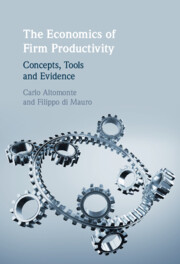Book contents
- Frontmatter
- Contents
- Figures
- Tables
- About the Authors
- Preface
- Acknowledgements
- 1 Introduction
- 2 Basic Concepts
- 3 Productivity Estimation
- 4 Measuring Market Efficiency
- 5 Sources of Data
- 6 Productivity and the Financial Environment
- 7 Productivity and the Labour Market
- 8 Productivity in a Borderless World
- 9 Productivity and Competitive Pressure
- 10 Conclusions
- Bibliography
- Index
10 - Conclusions
Published online by Cambridge University Press: 14 April 2022
- Frontmatter
- Contents
- Figures
- Tables
- About the Authors
- Preface
- Acknowledgements
- 1 Introduction
- 2 Basic Concepts
- 3 Productivity Estimation
- 4 Measuring Market Efficiency
- 5 Sources of Data
- 6 Productivity and the Financial Environment
- 7 Productivity and the Labour Market
- 8 Productivity in a Borderless World
- 9 Productivity and Competitive Pressure
- 10 Conclusions
- Bibliography
- Index
Summary
Using “average" indicators is simply misleading in most occasions, and firm-level analysis allows a much more targeted set of policies. Firm-level analysis is an essential tool to complement and integrate the macro assessment and related policy response across the whole range of productivity drivers – from labour to trade, from finance to competition. The great advantage of the CompNet dataset is that is built in such a fashion to be able to be used – as it is and directly – to derive at the very least a first set of granular stylised facts to inform policy considerations. Users can use the dataset to assess competitiveness, financial constraints and sensitivity to exchange rate fluctuations. The book has also presented a wide variety of applications of firm-level-based analysis which goes over and above the mere presentation of stylised facts and joint distributions coming directly out of the dataset, including zombie firms impacts, export and participation in global value chains and concentration and market power.
Keywords
- Type
- Chapter
- Information
- The Economics of Firm ProductivityConcepts, Tools and Evidence, pp. 199 - 206Publisher: Cambridge University PressPrint publication year: 2022

